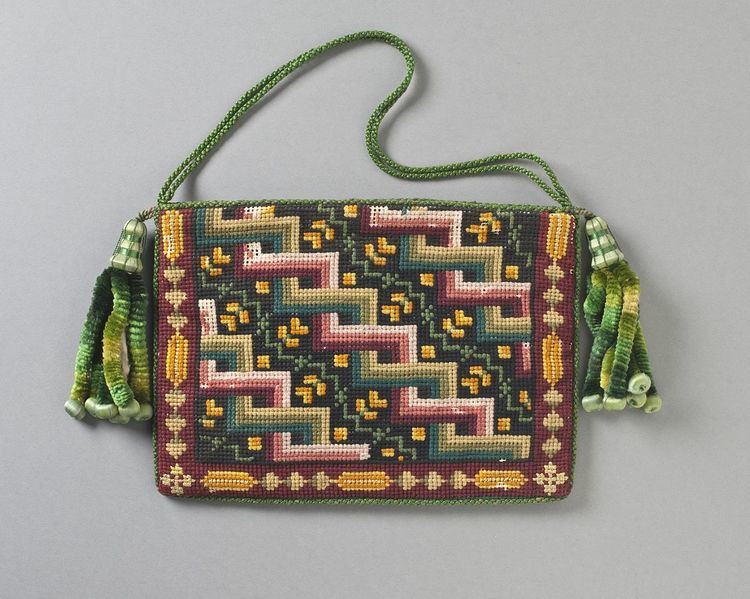 | ||
Berlin wool work is a style of embroidery similar to today's needlepoint. It was typically executed with wool yarn on canvas. It is usually worked in a single stitch, such as cross stitch or tent stitch although Beeton's book of Needlework (1870) describes 15 different stitches for use in Berlin work. It was traditionally stitched in many colours and hues, producing intricate three-dimensional looks by careful shading. The design of such embroidery was made possible by the great progresses made in dyeing in the 1830s, especially by the discovery of aniline dyes which produced bright colors.
Contents
This kind of work created very durable and long-lived pieces of embroidery that could be used as furniture covers, cushions, bags, or even on clothing.
History
Berlin wool work patterns were first published in Berlin, Germany, early in the 19th century. The first Berlin wool patterns were printed in black and white on grid paper and then hand-coloured. Previously, the stitcher was expected to draw the outlines on the canvas and then stitch following the colours on the pattern. Counted stitch patterns on charted paper, similar to modern cross-stitch patterns, made it easier to execute the designs, because there was no need for translating the patterns into actual wool colours by the stitchers themselves. They were published mostly as single sheets which made them affordable for the masses.
Soon they were exported to Britain and the United States, where "Berlin work" became all the rage. Indeed, Berlin work became practically synonymous with canvas work.
In Britain, Berlin work received a further boost through the Great Exhibition of 1851, and by the advent of ladies' magazines such as The Englishwoman's Domestic Magazine.
The popularity of Berlin work was due largely to the fact that, for the first time in history, a fairly large number of women had leisure time to devote to needlework.
Subjects to be embroidered were influenced by Victorian Romanticism and included floral designs, Victorian paintings, biblical or allegorical motifs, and quotations such as "Home Sweet Home" or "Faith, Hope, Love".
In the late 1880s, the demand for Berlin wool work decreased dramatically, largely because the tastes had changed, but Berlin work publishers failed to accommodate new tastes. Other, less opulent styles of embroidery became more popular, such as the art needlework advocated by William Morris and his Arts and Crafts movement.
Berlin wool work today
Original charted Berlin wool work patterns remain available in a number of books. Berlin wool work designs are still popular in trammed needlepoint canvases, printed canvas needlepoint kits and can be found as digitized charts on needlework enthusiasts' websites.
